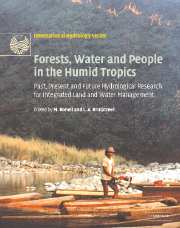 Forests, Water and People in the Humid Tropics
Forests, Water and People in the Humid Tropics from Part III - Forest disturbance, conversion and recovery
Published online by Cambridge University Press: 12 January 2010
INTRODUCTION
Many of the agricultural land use systems replacing tropical forest can be regarded as only semi-permanent. In shifting agriculture cultivated fields are abandoned within two to three years while pastures in Amazonia may have a productive period of only six to twelve years (Sanchez and Hailu, 1996; Uhl et al., 1988). Abandoned fields are usually left for secondary succession with trees and shrubs establishing in these areas initiating the forest recovery. In some tropical regions secondary forests already form the most important land cover and are likely to become more important as long as forest conversion proceeds and sustainable management systems for the deforested areas are lacking. Fearnside (1996) estimated that 30% of the deforested area of the Brazilian Amazon was covered by secondary vegetation in 1990. Similarly, in mainland South East Asia, a region with a long history of shifting cultivation, secondary forest comprises about one third in representative areas in northern Thailand (Fox et al., 1995), northern Vietnam (Fox et al., 2000) and southern China (Xu et al., 1999).
The conversion from forest to agricultural land use causes manifold changes in water and nutrient cycles and has been studied for different site conditions and degrees of disturbance (Malmer et al., Grip et al., this volume). This chapter reviews the changes in vegetation structure, dynamics of nutrient pools in soil and phytomass, and subsequent alterations of the hydrological cycle during the process of forest recovery on abandoned pastures and in shifting cultivation systems.
To save this book to your Kindle, first ensure no-reply@cambridge.org is added to your Approved Personal Document E-mail List under your Personal Document Settings on the Manage Your Content and Devices page of your Amazon account. Then enter the ‘name’ part of your Kindle email address below. Find out more about saving to your Kindle.
Note you can select to save to either the @free.kindle.com or @kindle.com variations. ‘@free.kindle.com’ emails are free but can only be saved to your device when it is connected to wi-fi. ‘@kindle.com’ emails can be delivered even when you are not connected to wi-fi, but note that service fees apply.
Find out more about the Kindle Personal Document Service.
To save content items to your account, please confirm that you agree to abide by our usage policies. If this is the first time you use this feature, you will be asked to authorise Cambridge Core to connect with your account. Find out more about saving content to Dropbox.
To save content items to your account, please confirm that you agree to abide by our usage policies. If this is the first time you use this feature, you will be asked to authorise Cambridge Core to connect with your account. Find out more about saving content to Google Drive.